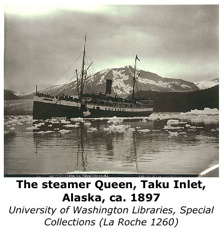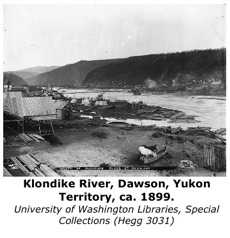His Quest for Fortune
In 1896, gold was discovered along Bonanza Creek in the Yukon Territory. Coming less than fifty years after the California Gold Rush, the strikes created excitement throughout the country, especially on the West Coast. Newspapers ran daily accounts of the fortunes and misfortunes of those venturing into Alaska and the Klondike in search of gold.
Captain Loomis was not immune, having spent time in his youth in mining and as an adult prospecting the local mountains. In 1898 he, along with several friends from the Los Angeles Police department, ventured into the wilderness in his own quest for fortune. His trip was financed in part by his employers at the Evergreen Cemetery in Los Angeles (Fred Dohs, Victor Ponet, and J. M. Elliot), where he was supervisor from 1889 to 1903. He left his wife Grace in complete charge of the Evergreen Cemetery during his absence.
Newspaper accounts glowingly described the group's capabilities and their preparations. The group included Captain Loomis, young Mark Warner, who had worked for Captain Loomis for some time, and two friends from the Los Angeles Police Department, Frank Benedict and Charles Moffatt. The Los Angeles Times proclaimed "It is safe to say that a stronger combination has not left Los Angeles for Alaskan gold fields since the rush began, than these four".
On January 19, 1898, just as the Klondike rush was reaching its peak, the group began their adventure, departing from San Pedro harbor. They traveled on the steamship "Queen" to Seattle, where they planned to outfit for their trip. They then continued on the Queen via the inside passage to Dyea, and then over the Chilkoot Pass to Lake Bennett, where they occupied themselves sawing wood to build two boats. Using a whipsaw, they cut about 1500 of board to build a scow and a skiff for the trip down the Yukon River to the Klondike.
They waited for the ice to break up, then proceeded down the river to Lake Labarge, where they had to stay for several days waiting for clear water. While there, they did some prospecting along the creeks that ran into the lake. Everywhere they panned, they found small amounts of fine gold. Once they were able to travel again, they proceeded down the river to the Stewart River, where they established camp and spent most of the summer prospecting along a creek they named Los Angeles. They washed out just enough gold to make the prospect seem worth working through the summer, but found nothing that would make them rich.
As fall approached, they proceeded to Dawson City where they planned to spend the winter. After linking up with several other men from Los Angeles, they built a 20' by 30' log cabin on the river bank across from Dawson City, and cut a supply of firewood for the winter. They got a lay claim located on Nugget Gulch, a small gulch off of El Dorado. Five of them worked the claim, thawing the ground by first building a fire, then digging down to frozen ground, and building another fire. The proccess was repeated until they reached bedrock, about 15 to 20 feet deep. They had very poor success. Three of the men quit before Mark Warner and Loomis finally gave up. They prospected the balance of the winter along the Dawson, Moosehide, and Fresno Creeks.
One of the men from Los Angeles, former sheriff Ed Gibson, brought word of claims on Jack Wade Creek on the American side. Traveling from Nugget Gulch, six men went fifty miles down river to Fortymile River, then up Fortymile about 15-20 miles to Jack Wade Creek. They worked the claims that spring on a creek they named Grace, and Captain Loomis filed a claim for their prospect. But their resources were running low, and during this trip Loomis had developed a case of scurvy from the poor provisions. They were finally forced to abandon their search, and as summer approached planned their return to Los Angeles.
Captain Loomis and Mark Warner arrived back in Los Angeles on July 29, 1989. While they did not find their fortune, they apparently returned healthier than their companions. It was reported that both had their hands, feet, and faces frozen (although not seriously), and Captain Loomis overcame a bout of scurvy. But they apparently managed to avoid the more serious health problems that many others experienced.
Frank Benedict returned in August, 1989, shortly after Loomis and Warner. After a year in the Yukon, he had developed a severe case of scurvy, and was unable to work his claims or accompany Loomis and Warner to Jack Wade Creek. Shortly after his return he underwent surgery to remove a tumor from his neck, reported to be a result of his attack of scurvy.
Charles Moffatt, according to early news articles the defacto leader of the group, lasted only a few months before reportedly having an attack of malaria. He returned to Los Angeles in October, 1898, weighing forty pounds less than when he departed. Interestingly, in his journal account of the trip, Captain Loomis does not discuss Mr. Moffatt's participation in their adventure, beyond mentioning that he was a member of their party when they left Los Angeles. Captain Loomis does describe a man he calls only "Jim" (the only person in Loomis' account of the trip with no last name given). "Jim" suffers from a number of problems, and as soon as they arrive in Bennett following their first summer in the Klondike, he departs on a steamer to return to Los Angeles. The circumstances surrounding "Jim's" departure from the Klondike are very similar to those of Mr. Moffatt.
For a more detailed and colorful description of Loomis' trip to the Yukon, see his journal description The Yukon.
[Initial Version: 03/22/07]
[Sources: Lester Loomis Journals, LA Times articles]

